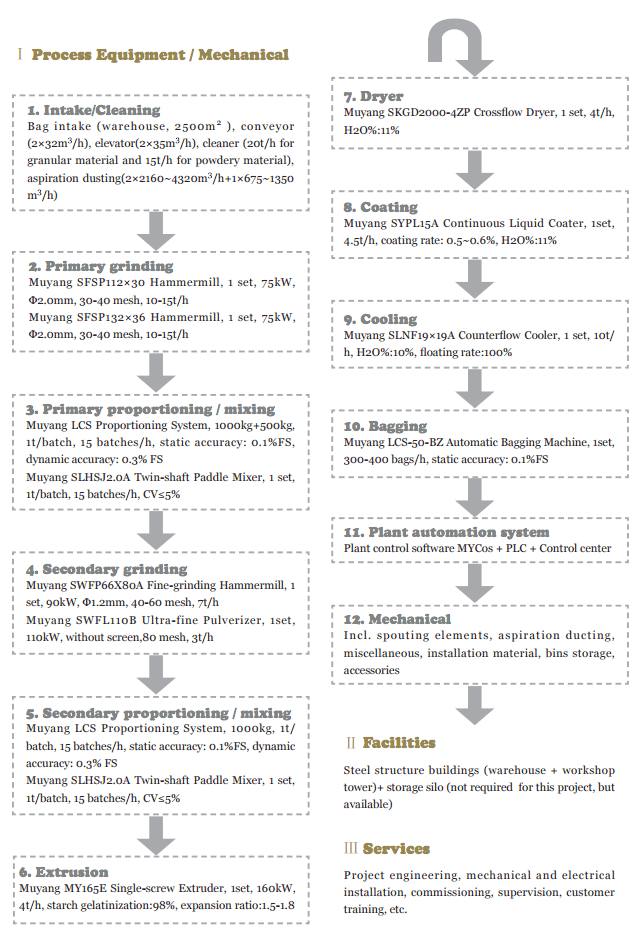Aquafeed extrusion: production process explained
Driven by the increasing consumption of fish meat due to world population boom and the limitation of wild catch, volume growth rate of global aquaculture has been sustained at about 8% over the last 10 years, and must continuously undergo a tremendous development in order to fill the huge gap between supply and demand for the premier protein sources. This represents a divine opportunity and a promising future for the aquafeed industry.
The unique physiology of aquatic animal is asking for special requirements in aquafeed manufacturing technology. This article will discuss the complete solution for aquafeed manufacturing based on Muyang’s years of experience as an aquafeed mill supplier and builder in such aquaculture regions as Asia, Latin America, etc.
1. Requirements of aquafeed
1) Grinding fineness: Proper particle size of ground materials can contribute to lower energy consumption of a feed mill, facilitate the subsequent conditioning process, increase the water stability of aquafeed pellets, and eventually obtain nutritional aquafeed that benefits the digestibility of aquatic animals.
2) Size of feed pellet: It is depending on the size of aquatic animal to be fed and its feeding habits.
3) Water stability: 45~90 min for shrimp feed and 5~30 min for common fish feed.
4) Floating / Sinking ability: Different aquatic animal species live in different depths of water (shallow water, middle water and deep water) and different habitats. Therefore, the feed for different aquatic animals should be sustainable in corresponding depths.
5) Palatability: Most of aquatic animals favor feed of special color, scent and flavor.
2. Aquafeed processing technology and equipment
Both pelleting process and extrusion process are adaptable to aquafeed production. As the development of aquaculture, however feed extrusion technology is more and more popular in the aquafeed production because of its well- balanced nutrition, the excellent water stability, and most of all, the environment friendliness. Usually, the common (pre-grinding) aquafeed extrusion process flow is as Fig 1.

2.1 Raw material receiving and cleaning
The designed capacity for raw material intake in an aquafeed mill shall be 2~3 times of its production capacity. For materials of different properties, special cleaning operation should be carried out where it is received. For instance, granular materials can be cleaned with a Muyang Drum Precleaner and the powdery materials with a Muyang Conical Precleaner, under the assistant of an aspiration system.
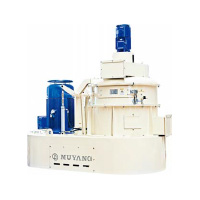 2.2 Primary grinding
2.2 Primary grinding
As the pretreatment of fine- grinding or ultra-fine grinding in aquafeed production, primary grinding (or coarse grinding) is designed to diminish the difference in and the variation of material particle size, to improve the working performance and working efficiency of the pulverizer thereof, and to ensure constant quality of finished products.
2.3 Primary proportioning and batch mixing
In such processing section, the major ingredients, i.e. the ingredients of larger proportion in aquafeed formulation, are batched by an electronically controlled proportioning system, and then sent to the mixer for primary mixing. Primary proportioning and batch mixing are designed to limit the variation of material particle size before ultra-fine grinding, so as to further ensure constant quality of finished product. The proportioning bins in this process section should be designed to have a storage capacity to sustain the 4~6 hours’ uninterrupted production of subsequent process.
2.4 Secondary grinding
Eating little, short digestive tract as well as bad digestibility of the aquatic animals require finely ground feed particles. See Table 1, Standard of grinding fineness for different aquafeed in China. Secondary grinding usually is executed by a specialised pulveriser (ultra-fine grinding) or a fine-grinding hammermill in Muyang solutions.
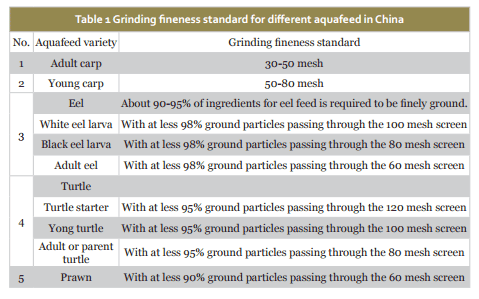
2.5 Secondary proportioning and batch mixing
The finely ground ingredients are fed into the other mixer for secondary batch mixing after proportioning. Usually, a manual feeding inlet is provided for adding micro ingredients into the secondary mixing mixer. And also two liquid application devices are furnished for adding water and oil respectively.
2.6 Extrusion and drying
1) Conditioning
Preconditioning is used to properly condition the material before the follow-up extruder cooking stage so as to supplies the extruder with a uniformly mixed and hydrated material by mechanical stirring and adding saturated steam. Under the turning and blending efforts of conditioner paddles, the moisture content of mash is uniform and the temperature is steady eventually.
Conditioning brings such advantages for extrusion as follows (see Table 2).
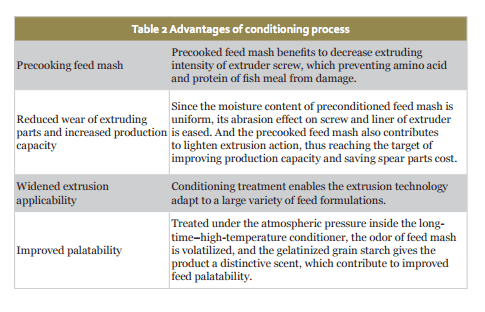
2) Extrusion
Extrusion process is mainly executed by an extruder that is basically composed of a stationary barrel housing in which such elements as segmented screws and shearlocks rotates, fulfilling extrusion operation together with a disc and knife assembly. There are two kinds of extruders that might be used in aquafeed production: the single-screw extruder and the twin- screw extruder.
Single-screw extruder: As its name implies, a single-screw extruder has only one extruding screw and is of simple structure, so its price is relatively lower. Since it has been applied in aquafeed manufacturing for over 40 years, the single-screw extruding technology becomes mature, and the working performance is relative stable and reliable.
Traditionally, single-screw extruders are widely used for producing the feeds for low protein adult fishes such as tilapia, catfish fish, grass carp, etc. Besides, for the cultivation of different fish species in lake, the grinding fineness of feed only requires that 95% of ground particles should pass through the screen of 30~50 mesh, which can be achieved by a common grinding process without ultra-fine grinding. In such case, the advantages of a single-screw extruder are obvious and superb, because of its low equipment cost and high production efficiency.
Twin-screw extruder: The twin- screw extruder is characterised by its wide adaptability, sliding conveying in the barrel and self-cleaning function, etc. However, it is relatively expensive due to the high primary investment and operation and maintenance costs. Therefore, the twin-screw extruder is usually applied in the production of petfood and feed for high value-added aquatic animals such as eels, soft-shelled turtle and young fish. For other special aquafeed production like the production of micro aquafeed (pellet size: Φ0.8~1.5mm), oil-rich aquafeed and the aquafeeds with changeable formulas, the twin screw extruder is of genuine differentiation.
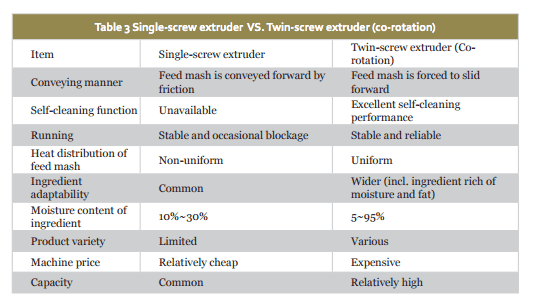
Refer to Table 3 above for the differences between single-screw extruder and twin-screw extruder (co-rotation screws) with the same capacity.
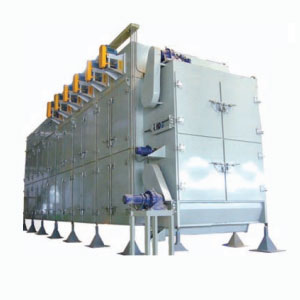 3) Drying
3) Drying
Once the product leaves the extrusion system, a drying step is required to remove the excess water and return the product back to a shelf-stable moisture condition. It is recommended to apply a crossflow dryer for drying wet extrudates, in which moisture and heat of product is exchanged with a perpendicular airflow.
2.7 Coating and cooling
If necessary, liquid fats, flavours, and vitamins can be added externally to extruded feeds after drying. Post liquid application by coating will not only avoid the risk of damaging heat sensitive ingredients, but also improve the palatability and reduce powder generation of the finished product. After coating, extruded aquafeed is cooled as required.
2.8 Bagging
When bagging aquafeed, the amount of air entrained in the bag or that penetrating into the bag should be controlled to a minimum, so as to prevent feed from oxidation and deterioration. Therefore, it is recommended to close the bag through sewing plus heat sealing (plastic film lining), which can prolong the shelf life of finished product by 50-100%.
3. Conclusion
Aquafeed production solutions are different from case to case. They should be tailor-made on the basis of a good understanding of the customers’ needs, the local market’s requirements and the aquatic animals to be cultivated. The equipment and process applied for an aquafeed mill shall be optimised by considering the long-term sustainable profitability.
Muyang extrusion aquafeed milling solution for CITICO Feed
Following are the solution details of a classical floating fish feed production line that Muyang provided to CITICO Feed in Sichuan Province, China. As a full-line aquafeed mill, the plant also includes three pelleting lines (one preserved for further expansion). The feed mill is a turnkey project delivered by Muyang Group.
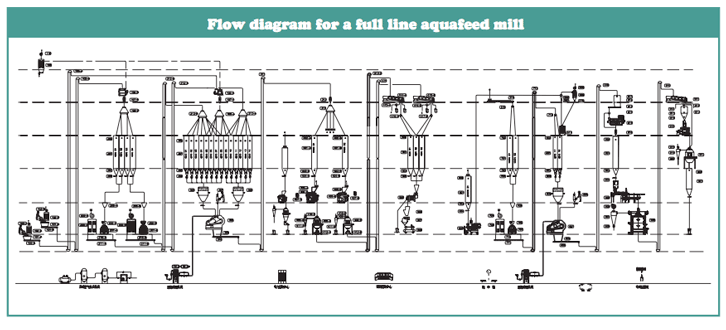
Technical requirements of the extrusion line:
1. Floating fish feed, 4t/h
2. Proportioning accuracy: static 0.1%FS, dynamic 0.3% FS
3. Mixing homogeneity: CV≤7%
4. Dust concentration: ≤10 mg/m3
5. Noise level of central control room: ≤75dB(A) 6. Plant automation system: computer control system
